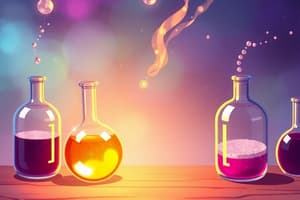Podcast
Questions and Answers
What is the formula for converting mass to moles?
What is the formula for converting mass to moles?
- $ ext{moles} = ext{mass} imes ext{molar mass}$
- $ ext{moles} = rac{ ext{mass}}{ ext{molar mass}}$ (correct)
- $ ext{moles} = ext{mass} - ext{molar mass}$
- $ ext{moles} = rac{ ext{molar mass}}{ ext{mass}}$
What does stoichiometry study?
What does stoichiometry study?
- Nuclear reactions
- Physical properties of substances
- Organic chemistry reactions
- Quantitative relationships in chemical reactions (correct)
How is molar volume calculated?
How is molar volume calculated?
- $ ext{PV} = n/T$
- $ ext{PV} = nRT$ (correct)
- $ ext{V} = nRT/P$
- $ ext{P} = nRT/V$
What concept helps to determine the amount of a substance that will be produced or consumed in a given reaction?
What concept helps to determine the amount of a substance that will be produced or consumed in a given reaction?
What does molar volume represent?
What does molar volume represent?
Flashcards are hidden until you start studying
Study Notes
Mole Concept
The mole concept is a fundamental concept in chemistry that deals with the quantities of substances. It is essential for understanding the relationships between the amount of a substance, its formula, and the number of particles it contains. In this article, we will explore key subtopics related to the mole concept, including Avogadro's number, molar mass, mole calculations, stoichiometry, and molar volume.
Avogadro's Number
Avogadro's number is the number of particles (atoms, ions, or molecules) in a mole of a substance. A mole is the base unit of amount of substance, and it is equal to 6.022 × 10^23 particles. Avogadro's number is used to convert between the number of particles and the amount of substance, which is measured in moles.
Molar Mass
Molar mass is the mass of one mole of a substance. It is calculated by adding the mass of each atom in a molecule or the mass of each ion in an ionic compound. The formula for molar mass is:
$$ \text{molar mass} = \frac{\text{mass of substance}}{\text{amount of substance}} $$
Mole Calculations
Mole calculations are used to determine the amount of a substance in a given sample. The most common mole calculation is the conversion of mass to moles, which can be done using the formula:
$$ \text{moles} = \frac{\text{mass}}{\text{molar mass}} $$
Stoichiometry
Stoichiometry is the study of the quantitative relationships between the reactants and products of a chemical reaction. It helps us to determine the amount of a substance that will be produced or consumed in a given reaction. In stoichiometry, we use the coefficients in a balanced chemical equation to determine the ratio of reactants and products.
Molar Volume
Molar volume is the volume that one mole of a substance occupies at a given temperature and pressure. It is calculated using the ideal gas law:
$$ \text{PV} = nRT $$
Where P is the pressure, V is the volume, n is the amount of substance (in moles), R is the gas constant, and T is the temperature.
In conclusion, the mole concept is a crucial foundation for understanding the relationships between the amount of a substance, its formula, and the number of particles it contains. By understanding Avogadro's number, molar mass, mole calculations, stoichiometry, and molar volume, we can effectively analyze and describe chemical reactions.
Studying That Suits You
Use AI to generate personalized quizzes and flashcards to suit your learning preferences.




